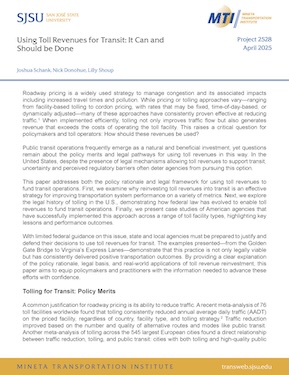- 408-924-7560
- mineta-institute@sjsu.edu
- Donate
Using Toll Revenues for Transit: It Can and Should be Done
Roadway pricing is a widely used strategy to manage congestion and its associated impacts including increased travel times and pollution. While pricing or tolling approaches vary—ranging from facility-based tolling to cordon pricing, with rates that may be fixed, time-of-day-based, or dynamically adjusted—many of these approaches have consistently proven effective at reducing traffic. When implemented efficiently, tolling not only improves traffic flow but also generates revenue that exceeds the costs of operating the toll facility. This raises a critical question for policymakers and toll operators: How should these revenues be used?
Public transit operations frequently emerge as a natural and beneficial investment, yet questions remain about the policy merits and legal pathways for using toll revenues in this way. In the United States, despite the presence of legal mechanisms allowing toll revenues to support transit, uncertainty and perceived regulatory barriers often deter agencies from pursuing this option.
This paper addresses both the policy rationale and legal framework for using toll revenues to fund transit operations. First, we examine why reinvesting toll revenues into transit is an effective strategy for improving transportation system performance on a variety of metrics. Next, we explore the legal history of tolling in the U.S., demonstrating how federal law has evolved to enable toll revenues to fund transit operations. Finally, we present case studies of American agencies that have successfully implemented this approach across a range of toll facility types, highlighting key lessons and performance outcomes.
With limited federal guidance on this issue, state and local agencies must be prepared to justify and defend their decisions to use toll revenues for transit. The examples presented—from the Golden Gate Bridge to Virginia’s Express Lanes—demonstrate that this practice is not only legally viable but has consistently delivered positive transportation outcomes. By providing a clear explanation of the policy rationale, legal basis, and real-world applications of toll revenue reinvestment, this paper aims to equip policymakers and practitioners with the information needed to advance these efforts with confidence.
Joshua Schank, PhD
Joshua Schank holds a PhD in Urban Planning from Columbia University and a Master of City Planning from the Massachusetts Institute of Technology. He is a Research Associate at the Mineta Transportation Institute, a Managing Principal at InfraStrategies, and a Senior Fellow in the Institute for Transportation Studies at the University of California, Los Angeles.
Lilly Shoup
Lilly Shoup is Managing Director of Rebel Payments, Mobility, and Insights where she works to structure partnerships to achieve community policy goals. She holds a Master’s in Urban Planning from the University of Maryland at College Park, a Bachelor of Economics, and a Bachelor of Public Policy from University of North Carolina at Chapel Hill.
Nick Donohue
Nick Donohue is a principal at Transportation and Infrastructure Strategies LLC. He provides strategic advice and consulting to public and private sector clients on a broad range of transportation matters including P3s, tolling, project prioritization, and innovation. Prior to this role, he served as Deputy Secretary of Transportation for the Commonwealth of Virginia.
Andrew Quinn
Andrew Quinn holds a Master’s in Urban Planning from New York University and a BA from Columbia University. He has held a variety of state, regional, and local government leadership roles in California.
-
Contact Us
San José State University One Washington Square, San Jose, CA 95192 Phone: 408-924-7560 Email: mineta-institute@sjsu.edu






